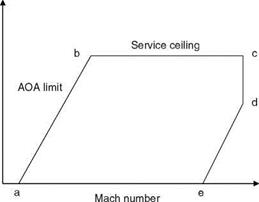PLANNING OF FLIGHT TEST MANEUVERS
An aircraft should generally fly in the specified flight envelop defined by the altitude and Mach number (and for any required configuration parameters). A typical flight envelope is shown in Figure 7.1 [9]. The low speed limit ‘‘a’’ is stipulated by the maximum lift that can be generated by the aircraft wings. The high speed limit is governed by a constant dynamic pressure contour. One can see that as the speed is reduced from point ‘‘d’’ to point ‘‘e,’’ the air density is increased due to the reduction in altitude. This would maintain the dynamic pressure nearly constant. At higher altitudes the speed of the aircraft is governed by available maximum thrust. Service ceiling occurs because the engine cannot produce the required rate of climb.
Flight test planning consists of (1) specification of flight conditions, e. g., flight test points in the envelope, (2) aircraft configuration, e. g., mass, center of gravity (CG) (forward, aft), use/deployment of flaps/slats, the undercarriage, i. e., landing gear in up or down position, and carrying of any stores, (3) axis-specific control inputs, e. g., elevator, aileron, rudder pedal, and (4) engine conditions, e. g., single or both engines on. It is also important to specify the instruments/sensors required to monitor, display, or collect the flight responses/data that will be used for analysis. The sensor/instrument package should be at the CG as far as possible, as the case
Altitude
|
|
FIGURE 7.1 A typical flight envelope.
may be. If the package is not at the CG, then the offset distance should be known and should be taken into account for correction of the data. Standard sensor/instrument packages should be used for accuracy and reliability of the data to be gathered. Sampling requirements must be specified well in advance. Flight test data processing skills are very important and require knowledge of signal processing and estimation methods. A complete flight test matrix consisting of these aspects with the full list of the requirements should be prepared and discussed with the concerned test pilots/flight test engineers. Flight tests exercises are generally carried out in several phases and often several aircraft versions (called technology demonstrators) are planned to concurrently undergo flight tests. This shortens the overall flight test time to go for certification. However, enough testing should be done in order to get the full confidence in the performance of the aircraft. This would need a gross time of hundreds of hours (that may run from 400 h onward depending on the type of the aircraft that is tested) of flight testing to scan all the important subsystems (propulsion, landing gears, flaps, airbrakes, electrical systems, cockpit instruments, actuators, movement of control surfaces, structural vibrations, head-up displays (HUDs), effect of movement of CG, fuel transfer from one tank to the other, etc.) of the aircraft and many configurations (stores/missiles/tanks, etc.). Thus, flight testing is an iterative exercise and requires a coordinated effort among the test pilots, flight test engineers, design engineers, and subgroups of data analysts. Other important factors to be kept in mind are [1-3,6] (1) for realizing a simple maneuver too much time should not be spent (in air) and (2) the CG shift, weight, and flight envelope should be considered at the outset. Properly planned and conducted flight test experiments save a lot of effort, fuel, and time for the flight test engineers, pilots, managers, and the analysts. For the sake of consistency of the results it is desirable to perform at least three repeat runs (maneuvers) at each flight condition. The flight testing of the aircraft and related systems should cover the following areas: (1) air data calibration (very crucial task for feedback control variables), (2) aircraft loads, (3) excitation and monitoring of flutter, (4) high AOA tests and related data generation maneuvers, (5) preliminary handling qualities (HQ) evaluation, (6) stability and control characteristics evaluation, (7) open/closed loops HQ, (8) testing of aircraft/subsystem failure modes/ states, (9) engine and drag performance tests, (10) critical stores testing, and (11) carefree handling (if applicable).












